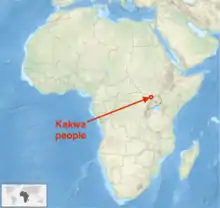Kakwa people
The Kakwa people are a Nilotic ethnic group and part of the Karo people found in north-western Uganda, south-western South Sudan, and north-eastern Democratic Republic of the Congo, particularly to the west of the White Nile river.[1]
| Regions with significant populations | |
|---|---|
| Languages | |
| Kutuk | |
| Religion | |
| African Traditional religions, Christianity and Islam |

Demography
The Kakwa people are a small minority but a part of the larger Karo people, an intermarried group that also includes the Bari, Pojulu, Mundari, Kuku, Nyepo, and Nyangwara. Their language, Kutuk na Kakwa, is an Eastern Nilotic language.[2]
The major cities of the Kakwa people are the city of Yei and Morobo County (South Sudan), Koboko District (Uganda), and Imgbokolo and Aba (Democratic Republic of the Congo). The Kakwa people sometimes refer to themselves as "Kakwa Saliya Musala", translated directly as "kakwa three hills" a phrase they commonly use to denote their 'oneness' in spite of being politically dispersed among three countries.[3]
History
According to the Kakwa oral tradition, they migrated out of East Africa (Nubian region) from the city of Kawa in between the third and fourth cataracts of the Nile. First into South Sudan, and from there southwards into Uganda and the Democratic Republic of the Congo.[1] The Kakwa converted to Islam, accepting the Maliki school of Sunni theology in medieval era. They were annexed into Equitoria region claimed by the Egyptian Islamic ruler Khedive Ismail (Isma'il Pasha) by his descendant Tewfik Pasha in 1889. As the British colonial empire expanded into East Africa and Egypt, the region with Kakwa people became a part of the Uganda Protectorate.[1]
%252C_R23930288.jpg.webp)
The Kakwa people rose to international prominence when General Idi Amin, of Kakwa ancestry, assumed the power in Uganda through a coup.[4] He filled important military and civil positions in his administration with his ethnic group,[4][5][6][3] and Nubians.[7] He arrested and killed officials from other ethnic groups such as the Acholi and Lango people, whom he doubted.[1] Idi Amin also supplied arms and financed the Sudanese Kakwa people in the first civil war of Sudan.[8] The Kakwa officials in Idi Amin regime were later accused of many humanitarian crimes. After Amin was deposed in 1979, many Kakwa people were killed in revenge killings, causing others to leave the area and fled to Sudan.[1] However, they have now returned to their native areas in the West Nile region of northern Uganda.[9]
Ethnic violence
For most of the South Sudanese Civil War, the fighting was focused in the Greater Upper Nile region. After the clashes in Juba in 2016, the fighting largely shifted to the previously safe haven of Equatoria, where the bulk of SPLM-IO forces went for shelter.[10] Accounts point to both sides targeting civilians on ethnic lines between the Dinka and the dozens of ethnic groups among the Equatorians who are historically in conflict with the Dinka, such as the Karo, who include the Bari.[11] Witnesses report Dinka soldiers threatening villagers that they will kill all Kakwa people for their alleged support to Machar and killing Pojulu people while sparing those who they find can speak Dinka.[12] A UN investigation said rape was being used a tool of ethnic cleansing[13] and Adama Dieng, the U.N.'s Special Adviser on the Prevention of Genocide, warned of genocide after visiting areas of fighting in Yei.[14]
Lifestyle
The traditional Kakwa livelihood has been based on cultivating corn, millet, cassava, fishing and cattle. The traditional villages of Kakwa are linked by their lineage, with male forming councils of elders. Polygyny is accepted, and the Islamic traditions are a part of the Kakwa people lives.[1]
See also
References
- Anthony Appiah; Henry Louis Gates (2010). Encyclopedia of Africa. Oxford University Press. p. 629. ISBN 978-0-19-533770-9.
- Kakwa languages, Ethnologue
- "Idi Amin's home developing through cross-border trade". Daily Monitor. Retrieved 20 August 2020.
- Kefa M. Otiso (2006). Culture and Customs of Uganda. Greenwood. pp. 31–33. ISBN 978-0-313-33148-0.
- Thabani ka Sigogo Sibanda (2011). Conflict Issues Across Disciplines: Conflict, Negotiation, and Mediation: African Experiences. Xlibris. pp. 67–68. ISBN 978-1-4568-1761-9.
- Phares Mukasa Mutibwa (1992). Uganda Since Independence: A Story of Unfulfilled Hopes. Africa World Press. pp. 79–81. ISBN 978-0-86543-357-1.
- Donald L. Horowitz (2001). Ethnic Groups in Conflict, Updated Edition With a New Preface. University of California Press. pp. 491–492. ISBN 978-0-520-92631-8.
- Donald L. Horowitz (2001). Ethnic Groups in Conflict, Updated Edition With a New Preface. University of California Press. pp. 274–281. ISBN 978-0-520-92631-8.
- The Republic of Uganda, Encyclopædia Britannica
- "Who can stop the threat of genocide in South Sudan?". irinnews.org. 14 November 2016.
- "South Sudanese flee as country edges closer to 'genocide'". reuters. 1 December 2016.
- "US seeks sanctions on South Sudan rebel leader, army chief". washington post. 19 November 2016.
- "UN:Rape used as a tool of ethnic cleansing in South Sudan". CBS news. 2 December 2016.
- "Hatred spills beyond South Sudan along with refugees". Reuters. 15 December 2016.